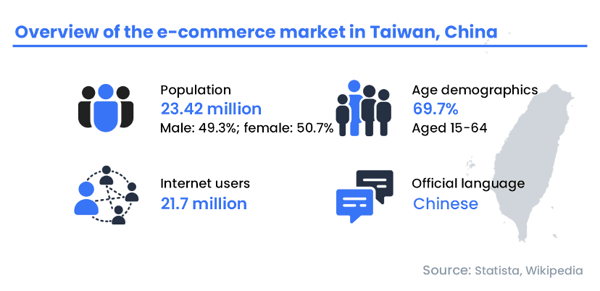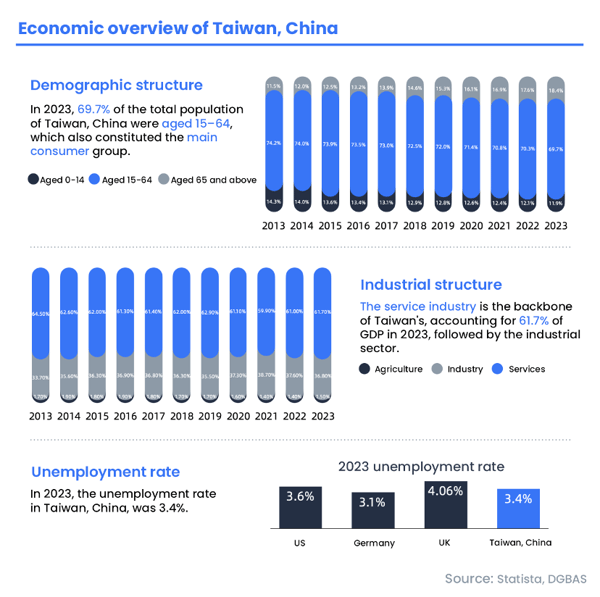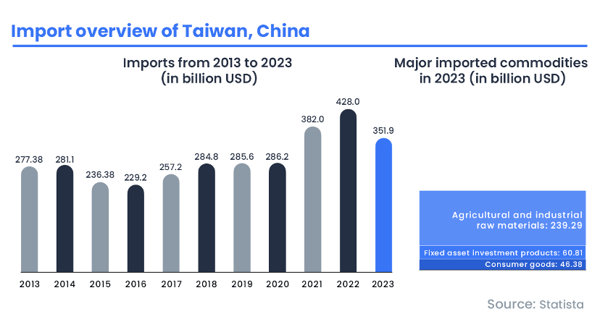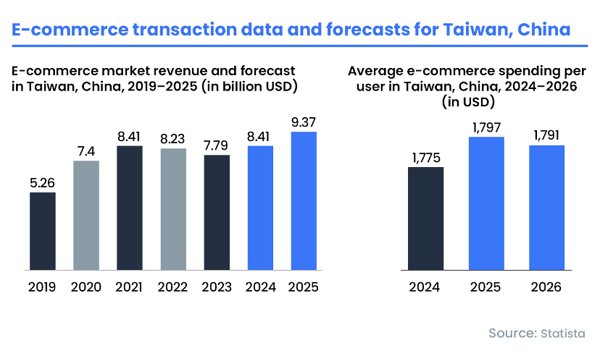Preface
Taiwan, China plays a vital role in the global semiconductor supply chain and is emerging as a dynamic digital commerce market in its own right. This report explores the region’s economic profile, e-commerce growth, consumer behaviour, and evolving payment preferences. With nearly 76% of online shoppers aged 30–39 making purchases online and credit cards and digital wallets leading in digital transactions, Taiwan, China reflects a digitally engaged, mobile-first consumer base. As digital payment adoption expands and online retail continues to evolve, the market offers increasing opportunities for global merchants and payment providers.
Key Insights
- The majority of online shoppers in Taiwan, China are under the age of 59, with the highest proportion found among young adults aged 30 to 39. In this segment, the online shopping penetration rate reaches 89%.
- 34% of respondents reported making multiple online purchases each month.
- 35% of consumers indicate that enhancing the self-checkout experience is key to improving the overall shopping experience.
- A swift and seamless online checkout process is one of the key factors driving online shopping among consumers in Taiwan, China.
- In 2023, credit card payments were the most popular e-commerce payment method, closely followed by digital wallets.
Taiwan, China’s economic landscape: resilience, services, and industrial strength
Taiwan, China has a population of 23.42 million, with a balanced gender distribution. The labour force accounts for 69.7% of residents aged 15-64, and Mandarin is the official language.

In 2023, GDP reached USD 755.1 billion, with a per capita GDP at US$32,443. The e-commerce sector has grown steadily, with 4.3 million online shoppers recorded in 2023 and projections rising to 6.9 million by 2029. According to Statista, e-commerce revenue is expected to expand at a CAGR of 7.79% from 2024 to 2029.

Debit card ownership stands at 65%, while the credit card penetration rate has reached 57%.

Economic overview of Taiwan, China
In 2023, nearly 70% of the population fell within the 15–64 age range, forming the core consumer group. Services remain the largest economic contributor at 61.7% of GDP, while industry accounts for nearly 40% and has grown even faster than services over the past decade. Thanks to its crucial role in the global high-tech supply chain, the unemployment rate in 2023 remained low at just 3.4%.

The economy is heavily trade-oriented. In 2023, merchandise exports represented around 60% of total GDP, while the trade surplus reached US$80.6 billion, ranking among the highest globally. Limited natural resources mean raw materials must be largely imported, with agricultural and industrial goods forming the main import categories. Owing to its geographical proximity and long-standing commercial ties, mainland China remains the largest trading partner for both imports and exports.

This overview provides the economic context for the market. The next section examines consumer behaviour and purchasing trends in more detail.
Evolving consumer habits and online shopping behaviour in Taiwan, China
According to the National Bureau of Statistics of China, GDP in the second quarter of 2024 grew by 4.7% year-on-year. Research from Taiwan Institute of Economic Research also shows that the economy remained resilient throughout 2024. Supported by stable domestic demand and a gradual recovery in exports, full-year GDP growth is expected to exceed 4%.
Domestic consumption is projected to stay steady, backed by a healthy labour market and rising wages. On the investment side, continued expansion in the semiconductor sector and a push towards supply-chain localisation are expected to drive fixed capital formation, which is forecast to increase by nearly 5%.
Looking ahead to 2025, the economy is expected to remain stable internally, while showing gradual improvement externally.
Household income and expenditure data from Directorate‑General of Budget, Accounting and Statistics provide further insight into consumption patterns.

In 2023, average annual household income was approximately TWD 1.44 million, with wages accounting for 52.6%. Housing services and utilities such as water, electricity, and gas represented the largest share of household spending at 24%.
The favourable economic environment has created new opportunities for merchants. The following sections explore the state of physical retail and e-commerce in the market.
Physical retail
The physical retail sector remains a significant pillar of economy, contributing to both GDP and employment. Retail channels range from department stores and hypermarkets to a dense network of convenience stores. Major chain stores such as 7-Eleven and FamilyMart are deeply embedded in daily life, creating a highly accessible retail ecosystem. As of mid-2022, FMCG sales were still predominantly offline.
According to Mordor Intelligence, the retail market size is projected to reach US$36.01 billion in 2024 and grow to US$45.48 billion by 2029 — a CAGR of 4.78% between 2024 and 2029.
E-commerce
E-commerce growth continues to accelerate, driven by high smartphone penetration, mature logistics and telecommunications infrastructure, and shifts in buying habits following COVID-19. Younger consumers, in particular, increasingly rely on online shopping for everyday goods and groceries.
Social media platforms — especially Facebook — play a central role in e-commerce marketing. Word-of-mouth sharing and cost-efficient promotional campaigns are key traffic drivers. Major online sales events such as “Double 11” and “Double 12” also boost volume, while traditional retailers are expanding into digital channels, further integrating online and offline retail. Fresh food e-commerce still faces challenges, but improving supply chain and stronger consumer confidence point to significant potential.
In 2023, the e-commerce sector had roughly 4.3 million users, representing a penetration rate of 20.8%. By 2029, the user base is projected to reach 6.9 million, with penetration rising to 31.9%.

Market revenue is estimated at US$7.79 billion in 2023 and is expected to grow to US$9.37 billion by 2025. Average spending per e-commerce user is expected to reach US$1,797.

These figures point to strong long-term growth potential. To further understand the consumption landscape more deeply, it is useful to examine user behaviour and purchase patterns.





